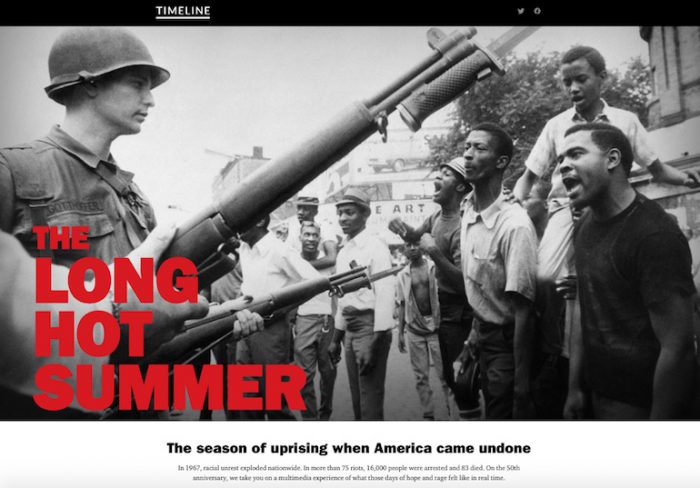
1967: More than 75 race-fueled riots engulf communities across the United States, sparked by angry mothers hosting a sit-in at a Boston welfare office that turned violent.
2014: Venture capitalist Tamer Hassanein and Russian investor Leon Semenenko create Timeline, with the mission of contextualizing the news in history.
2015: Timeline is featured on the App Store as the best app of January.2016: Jim Giles, a cofounder of longform journalism site Matter, takes over as CEO and shifts the editorial direction to focus on untold stories on topics like social justice, politics, and the environment.
June 2017: Fifty years after the start of the 1967 riots, Timeline unveils its Long Hot Summer project, digging through archives and building a master timeline to share narratives, videos, and photos. Editor-in-chief Brian Thomas Gallagher and his team in San Francisco post the content on the same days that the events took place in 1967, over the course of two months.
“The intensity and frequency of the riots was hard to imagine…There’s a lot of context around last summer and Ferguson. This was so much more violent and widespread,” Gallagher told me. “I thought it would be interesting to kind of let that unfold to readers, to get a sense of that intensity with how the story is published.”
These are more than just anniversary posts, though, and that’s true to Timeline’s mission.
“If you think about history through the lens of the present, you can create media of our history that we think is unusually compelling and powerful,” CEO Giles said. “We don’t think about what are the most important events of the 21st century. We’re not giving history lessons.”
Instead, Timeline has refocused to pay more attention to the parts of history that lacked attention from main media organizations at the time. Its website includes two distinct sections for women’s history and black history, and Timeline regularly highlights unsung moments in LGBT history as well.
It’s in line with what Timeline’s target audience of 25-to-45-year-old Americans wants, Giles believes, reflecting their growing interests in social justice and equality. The content is then distributed through written stories, photo essays, and social video shared through social media, an email newsletter, an app, and the website itself.
“The challenge…is to tell them so they each have a story that’s more than ‘then someone threw a bottle and then the National Guard came in,’ but to have them all be meaningful on their own,” Gallagher said. “There was a balance I wanted to strike with acknowledging some of the truths of why these things happened, some validity to the anger, and political disenfranchisement without starting off in a polemical way.”
 Gallagher took out a whiteboard and plotted the timeline, working with the team to develop the themes and in-depth stories they wanted to investigate before putting out a call for pitches. Carvell Wallace, the special project editor, spearheaded the solicitation and navigation with the responding writers. But they hit a roadblock when it came to finding historical records of these stories, especially because some smaller news organizations that might have reported on the riots were either no longer around or didn’t maintain searchable records.
Gallagher took out a whiteboard and plotted the timeline, working with the team to develop the themes and in-depth stories they wanted to investigate before putting out a call for pitches. Carvell Wallace, the special project editor, spearheaded the solicitation and navigation with the responding writers. But they hit a roadblock when it came to finding historical records of these stories, especially because some smaller news organizations that might have reported on the riots were either no longer around or didn’t maintain searchable records.
“If you can’t find a copy of the Tampa paper from June 1967, The New York Times will have a story on the Tampa event. It won’t be as rich or as textured, but it’s a start,” Gallagher said. Sometimes, it was the residents of the towns who provided the true launchpad: Gallagher found a “true crime aficionado” in Ohio who helped him learn more about a black man charged as the Cincinnati Strangler, a serial-killer case that heightened racial tensions in the community.
That community aspect has expanded beyond the Long Hot Summer project, too. One video tells the story of an African-American man who flew for the French air force in World War I after the U.S. wouldn’t accept him because of his race; Giles said that some of the man’s distant relatives met in the Facebook comments on that video. (Charlotte Buchen leads the video team.)
“We see really positive, enthusiastic engagement on Facebook,” Giles said. “It’s one of the things we’re proudest of.” He added that in the first quarter of 2017, Timeline’s videos on Facebook and stories on its website have been averaging “tens of millions” in views monthly, compared to “a very small base just a year prior.”
When Timeline was first gaining steam, in 2015, venture capitalist and cofounder Hassanein suggested various sources of revenue, such as sponsored content. Giles said the team is considering that, as well as developing a membership base and crowdfunding.
“We’re trying to do one thing, which is to put Timeline on a sustainable footing. We’re very fortunate to have a funder who is in this for the long run with us…but we are a for-profit company,” Giles said.
Translation: stay tuned. “The main thing is that the immediacy of the issues in the Long Hot Summer project and the relevancy of it today is really a microcosm of why the Timeline editorial mission is so important,” Gallagher said. “People really related to it when they started to realize that history is still super relevant.”